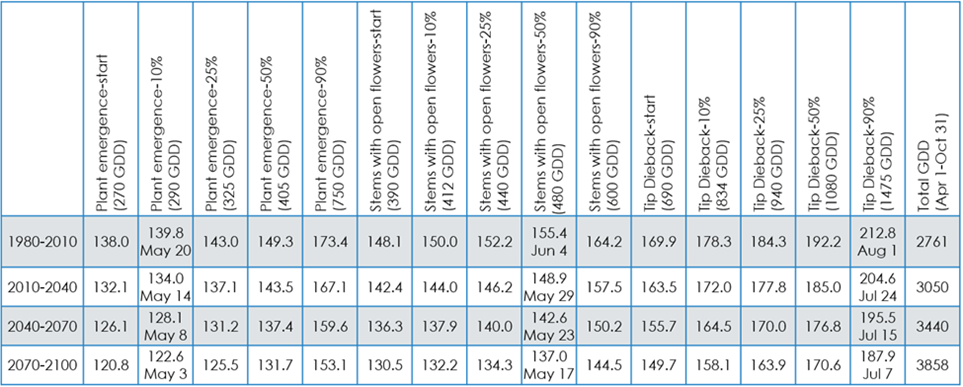Introduction
A recent collaborative effort by CLIMAtlantic, Perennia, and the Nova Scotia Department of Agriculture has taken a look at climate data to help local wild blueberry growers make better sense of the changing climate. By examining growing degree days (GDD) – a measure of how much heat is available during the growing season – the project offers valuable insights into the growth and development of plants. For example, research has pinpointed specific GDD milestones, such as when plants emerge and start to flower. This GDD model is widely used in Nova Scotia’s wild blueberry industry. The model takes into account a start date of April 1 and a base temperature of 0 degrees Celsius.
Interestingly, the wild blueberry GDD model reveals 15 crucial thresholds, which are tied to plant emergence, flower opening, and tip dieback percentages. As a case in point, in a fruit-bearing year, about 25% of stems are expected to have open flowers when they reach 440 cumulative degree days. This type of information allowed the research team to pinpoint when each GDD threshold is met historically and in model projections, helping them understand if these dates are changing over time.
What climate data was used?
This project used daily historical weather station data and daily downscaled CMIP6 climate model data from ClimateData.ca. Weather station data was needed to understand historical variability in the dates when GDD thresholds were met, and to identify if there have been any trends in these dates within the observational data record. Climate projections were required to calculate the magnitude of change that can be expected in the future. Both the station data and variable data were obtained from ClimateData.ca.
While cumulative degree day data is readily available through ClimateData.ca on annual, seasonal, and monthly timescales, daily projection data was required in this case to identify the average date where specific GDD thresholds were exceeded. This involved downloading the daily minimum and maximum temperature data for the years 1950-2100 for three locations of interest, corresponding to important wild blueberry production regions in Nova Scotia. Daily mean temperatures were calculated from these maximum and minimum values, which could then be used to calculate cumulative degree days above 0 degrees Celsius for each day of the growing season (April 1 – October 31). The results could then be analyzed to determine on which day of the year each of the GDD thresholds of interest were met. Results from multiple models were examined, with the median value from the models for each year used to calculate a 30-year rolling average.
What did the data show?
A closer look at historical weather station data showed the average dates for reaching GDD milestones have been fairly consistent over many decades. While weather patterns can change from year to year, in most cases, each GDD threshold is typically met within a 10-day window of the long-term average. However, a notable shift has occurred during the most recent 30-year period (1990-2020), with GDD thresholds consistently being met several days earlier. Additionally, there is a clear upward trend in the total number of growing degree days within the historical data record, suggesting our climate is indeed changing.
Looking towards the future, an analysis of the downscaled climate model data identified the changes we can anticipate in the years to come. Compared to the recent past (average conditions between 1980-2010), we can anticipate that GDD thresholds may be reached on average one week earlier in the near-term (2010-2040). This increases to around two weeks earlier by mid-century (2040-2070), and nearly three weeks earlier by the end of the century (2070-2100) under a high-emissions scenario.
The table below shows results for Truro, Nova Scotia. The numbers indicate the average day of the year when each GDD threshold was met during each time period, with several columns also including the corresponding month and day for illustrative purposes. For example, we can see 10% plant emergence (at 290 GDD) could be anticipated to occur on May 20 (day 140) during the period 1980-2010, on May 14 (day 134) during 2010-2040, on May 8 (day 128) during 2040-2070, and on May 3 (day 123) during 2070-2100. All results shown here assumed a high emissions scenario (SSP5-8.5).
These changes assume April 1 will remain the start date for the growing season in Nova Scotia. As continued climatic warming results in the last frost in spring occurring on average earlier in the year, the growing season timeframe may need to be adjusted to an earlier date, which may cause GDD thresholds to be reached even earlier.
How will these data be used?
As the climatic characteristics of our growing season continue to change, producers will be faced with new risks and new opportunities. Crops may develop earlier in the season, and the potential exists to produce more food or grow different types of crops. However, warmer temperatures may also increase water stress, conditions may be more favourable for pests and disease, and the timing for events like pollination may change. As crops emerge earlier, they may also be more at risk of experiencing damage during a late frost event. While this work on GDD trends does provide some valuable insights into climate impacts, we need to remember that one variable alone does not tell the whole story. Climate information can help us to understand complex climatic changes, make informed choices about the production of specific commodities like wild blueberry, and ultimately better position the agriculture sector to continue thriving in the years ahead.
Acknowledgement
This work was a collaborative effort between staff at CLIMAtlantic, Perennia Food and Agriculture, and the Nova Scotia Department of Agriculture.

